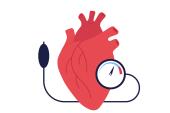PA Pressure Monitoring Benefits HF Patients With No Recent Hospitalization
The single-arm data from GUIDE-HF imply that PA sensors might be useful across a spectrum of HF symptoms and risk categories.

Patients with moderately symptomatic heart failure (HF) and elevated levels of NT-proBNP, but no recent HF hospitalization, see significant clinical and quality-of-life benefits from pulmonary artery (PA) pressure monitoring, a new analysis from the single-arm portion of the GUIDE-HF trial suggests.
The findings indicate that hemodynamic monitoring using PA sensors, which provide an early warning system for identifying patients who require drug or device adjustments to evade episodes decompensation, might be warranted in this lower-risk group of patients identified on the basis of NT-proBNP levels alone, the researchers say.
The CardioMEMS implantable PA sensor (Abbott) was approved by the US Food and Drug Administration in 2014 as a preventive strategy in patients with NYHA class III HF who have had a hospital stay for HF within the prior year based on the CHAMPION trial. Supported by the randomized, sham-controlled, GUIDE-HF trial, the US indication was further extended to those with NYHA class II to IV HF and either a prior hospitalization or elevated NT-proBNP.
To understand whether there was any difference in outcomes between patients with elevated natriuretic peptides alone and those with a prior hospitalization, a separate, active-management, single-arm study within GUIDE-HF—run in parallel with the randomized trial—enrolled 1,358 patients with NYHA class III symptoms, all of whom underwent PA sensor implantation.
Presenting data for the single-arm patients at the Heart Failure Society of America (HFSA) 2023 annual scientific meeting earlier this week, Mandeep Mehra, MD, MSc (Brigham and Women’s Hospital and Harvard Medical School, Boston, MA), showed that the reductions in PA pressure were similar in patients with biomarker elevations only and in those with prior recent hospitalizations out to 1 year. Moreover, similar percentages of patients in both groups had sustained or improved NHYA class at both 6 months and 1 year. Additionally, both groups had similar improvements in quality of life.
“We believe, based on this data, that this supports the indication for the use of CardioMEMS implantation and hemodynamic-guided management in the presence of elevated natriuretic peptides, but prior to occurrence of heart failure hospitalizations,” said Mehra.
Compared with patients who had a prior HF hospitalization, those with elevated NT-proBNP only were older, had a lower body mass index, and were less likely to be female or Black. These patients also were also less likely to be diabetic, but they had a greater incidence of atrial fibrillation and lower ejection fractions. Guideline-directed medical therapy at baseline was better in those with elevated NT-proBNP, which Mehra said may reflect the fact that these were patients with a greater prevalence of left ventricular systolic dysfunction.
The risk for hospitalization is going to be greater in those individuals who had previously been hospitalized, but there still is residual risk in those individuals identified only by N-terminal proBNP. Barry H. Greenberg
At 1 year, the rate of the primary efficacy endpoint (HF hospitalizations, urgent HF visits, and death) was lower in the elevated NT-proBNP group versus the prior HF hospitalization group (HR 0.51; 95% CI 0.44-0.60), falling outside the margin for equivalence. Similar trends were seen for the individual components of the primary endpoint.
For the secondary endpoint of HF hospitalizations at 1 year, there was a 54% reduction in those with a prior HF hospitalization versus a 27% reduction in the group with elevated natriuretic peptides only.
Between baseline and 1 year, PA pressures fell an average of 2.4 mmHg in the elevated NT-proBNP group and 2.05 mm Hg in the hospitalization-only group, which was significant for both, with a nonsignificant between-group difference (P = 0.23).
Changes in NYHA class also were not significantly different between the groups at 1 year (P = 0.28). Looking at quality of life, the Kansas City Cardiomyopathy Questionnaire (KCCQ) overall summary score gains from baseline also were similar and statistically significant for both (P < 0.0001).
Not Distinct Phenotypes
Following the presentation, discussant Barry H. Greenberg, MD (University of California, San Diego), said the study addresses an interesting hypothesis, namely that the strata of patients with HF identified by natriuretic peptides may respond differently to early detection and treatment than those identified by a prior HF hospitalization.
“These are not distinct phenotypes,” Greenberg said. However, “I think what the data shows us is that there is a spectrum of heart failure, of symptoms, and of risk in patients with class III heart failure.”
He added that the distinct risk picture seems to transcend ejection fraction class since it was seen across the spectrum of left ventricular ejection fraction.
Greenberg said what the data tell him is “that patients with NYHA class III symptoms across the spectrum of heart failure with classification by ejection fraction who have congestive symptoms will benefit from CardioMEMS regardless of whether they're hospitalized or whether or not they're identified with high levels of natriuretic peptides. The risk for hospitalization is going to be greater in those individuals who had previously been hospitalized, but there still is residual risk in those individuals identified only by N-terminal proBNP. And in that class of patients, you can significantly reduce hospitalizations and improve the symptomatic burden.”
L.A. McKeown is a Senior Medical Journalist for TCTMD, the Section Editor of CV Team Forum, and Senior Medical…
Read Full BioSources
Mehra MR. Primary results of the prospective single arm trial of hemodynamic-guided management of heart failure (GUIDE-HF). Presented at HFSA 2023. October 9, 2023. Cleveland, OH.
Disclosures
- Mehra reports consulting for Abbott, Janssen, Natera, Paratonic, Moderna, Broadview Ventures, NupulseCV, Mesoblast, the Baim Institute for Clinical Research, Fineheart, Transmedics, and Leviticus.





Comments